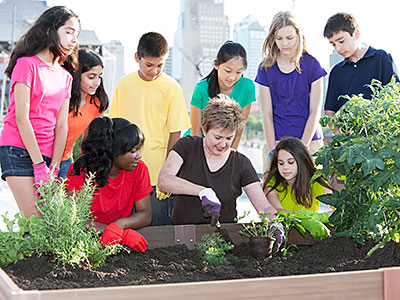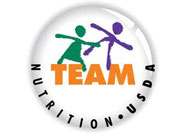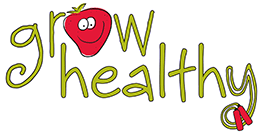
Fact Sheet FS1239
Schools play an important role in the promotion and maintenance of their students' health. Healthy students are better learners. But schools can't do it alone. Parents are the other crucial half of the equation to provide the healthy start that kids need to thrive in the classroom and in life. Research clearly shows that good nutrition and plenty of physical activity are vital to children's academic success. That's why it's so important for schools to engage parents in school health and wellness efforts and provide parents with the knowledge, skills, and support they'll need to maintain their children on the path of health, wellness, and academic success.
According to the Centers for Disease Control and Prevention (CDC), parent (or other adult primary caregiver) engagement in schools occurs when parents and school staff work together to support and improve the learning, development, and health of children and adolescents. Research has found that students whose parents are involved in their education have a greater likelihood of better health and educational outcomes than those whose parents are not involved. Children achieve higher grades and test scores, better school attendance, higher self-esteem, improved social skills, higher graduation rates and lower rates of risk-taking behavior. These positive outcomes are found regardless of race/ethnicity, class, or parents' level of education.
Family and community involvement is an integrated school, parent, and community approach for enhancing the health and well-being of students. The CDC Coordinated School Health Model states that school staff should demonstrate to parents how their children's health and education can be enhanced by their engagement in school health activities, and that parents tend to be more involved if they perceive that school staff and students both want and expect their involvement.
The School-Parent Partnership in School Wellness Initiatives
Parents want what is best for their children. They want to see that their input makes a difference in their children's outcomes. Similarly, educators work to impact children's lives in a holistic and positive way. Therefore, a commonality exists for school administrators, teachers, staff, and parents to work together to support the growth of healthy and productive children. Many school districts have found that professional development programs are needed to teach administrators and teachers the skills and knowledge they need to help make healthy habits a routine part of how kids learn, and the skills teachers need to engage parents in this process. One such program, The Healthy Schools Campaign Fit to Learn program, instructs teachers on how to integrate movement into lessons, and impresses the value of sending home consistent messages to ultimately shift the school culture toward the healthier end of the spectrum. The Campaign recommends integrating the idea that healthy students are better learners into common interactions between educators and parents such as parent-teacher conferences, open houses, and other school-based community activities, and reiterating this healthy message in printed materials such as the school mission statement, newsletter, website, student report card, and more.
The first step in creating a culture of wellness in which parents are engaged is making student and school wellness a priority. This necessitates the establishment of a positive relationship between school staff and parents. This can be accomplished by having a clear school vision for parent engagement in children's health and communicating that vision to the entire school community.
Schools should strive to:
- Create a family-friendly welcoming place for parents to contribute to the school's wellness activities, services, and programs. Display a welcome sign, in languages spoken by all families, to greet families and visitors.
- Train staff, including main office staff, to greet and communicate with families in ways that show that they are valued members of the school community.
- Offer professional development opportunities for staff members to learn to work with parents and promote parent engagement.
- Develop multiple means of two-way communication between family and school personnel.
- Investigate, via surveys or focus groups, parents' needs, interests, and ways they would like to be involved in their children's and school's health activities
- Include questions about parents' talents and availability that may contribute to the school health environment, as well as what health topics spark their interest. Also ask about barriers to involvement such as work schedules, child care, and transportation.
- Plan school activities that address parents' health interests and remove identified barriers to their participation.
- Encourage staff to model healthy behaviors in order to demonstrate a commitment to student and family wellness during the school day and at family events.
- Build parent confidence and empowerment by creating opportunities for shared decision-making related to school health policies, services, and programs.

Figure 1.
Educating Families about School Wellness
While the outreach efforts listed above may be a sufficient start, parents may need further education on how to engage in school wellness. Schools need to provide parents with the information and skills they need to support healthy attitudes, behaviors, and environments for their children both at home and in school. There are many ways in which schools can do this.
- Provide a variety of learning opportunities for families to learn about child and adolescent development; how nutrition and physical activity impacts a student's ability to learn; how to set expectations for appropriate healthy behavior and academic performance; and healthy cooking/fitness tips. These topics can be addressed in a specific workshop or as a part of established activities, such as report card pick-up day, and can be offered by school personnel or through collaborations with community partners such as the local Cooperative Extension service.
- Hold a family health fair.
- Make information easily accessible through newsletters, handouts, phone calls, email, social media, and school websites. Be sure to offer translated versions of this information for anyone who may need it.
- Provide families with information about the school nutrition program.
- Provide meeting opportunities for parents at a variety of times to accommodate different work schedules. Offer a meal and child care to eliminate these two major hurdles to family participation.
- Offer "town hall" style meetings to solicit parent input and opinions on topics such as changes to the school meal patterns, new curricula, or the addition of a school garden.
- Meet with the PTA/PTO to discuss school wellness.
- Place a suggestion box near the school office.
- Create a calendar that integrates wellness messages and reminders about regularly scheduled wellness activities, such as workshops, wellness team meetings, and health screenings.
- Encourage healthy habits, such as gardening and healthy eating, which children can practice at home with their families.
- Connect classroom learning to the home by assigning "healthy homework" such as asking students to sample vegetables and fruits beginning with the letter of the week or color of the week; sending home a physical activity calendar and asking students to report on what they and their family members participated in over the weekend; recording alternate activities to screen time; offering extra credit for participating in community health and wellness activities together, such as 5K walks/runs, visiting a farmers market, or walking or biking to school.

Figure 2.
Parents as Volunteers in School Wellness
Very often parent involvement begins with volunteer opportunities. Establishing a parent volunteer recruitment and training process focused on school wellness initiatives can be very valuable. Volunteers are often skilled at organizing and networking and may have particular connections to community resources that support wellness initiatives. Volunteers can help with classroom activities, gardening projects (see side bar for more details), and lunch-time walks or after school exercise programs. They may serve as mentors or tutors for school health activities or provide peer support for parents of students with special health care needs (e.g., asthma, diabetes, or food allergies). They may identify or assist with wellness-related grant applications.
Schools which participate in federal school lunch or breakfast programs are mandated to have a School Wellness Council. School Wellness Councils (SWCs) provide guidance on wellness policies, programs, and practices, and are effective in bringing school personnel, families, and community members together to promote healthy habits for students and staff. SWCs are required to be representative of the cultural diversity of the community and may include school board members, school administrators, counselors, nurses, health and physical education teachers, classroom teachers, nutrition and food service staff, maintenance and transportation staff, students, and parents. According to the Healthy Schools Campaign, parent involvement is critical to a successful wellness team. By working as part of a wellness team, parents can be the face of health and wellness initiatives in your school, increasing peer-to-peer interaction with other parents and creating a comfortable environment in which they can engage.
Building Family and Community Involvement through School Gardens and Farm-to-School Efforts
School garden activities and Farm to School (FTS) programs can create a community environment where students, teachers, and families learn healthy habits together. According to the National Farm to School Network, "FTS is the practice of sourcing local foods for schools and providing agricultural health and nutrition education opportunities such as school gardens, farm field trips and cooking lessons. FTS improves the health of children and communities while supporting local and regional farmers."
School gardens are interactive classrooms for students to learn first-hand how to plant, tend and harvest fruits, vegetables, and herbs. Research shows that children are much more likely to try a new fruit or vegetable they have grown themselves. Gardening is also fun physical activity.
Family members, including grandparents, who have familiarity with, and a love of gardening, offer invaluable multi-generational and cultural enhancements to the gardening experience. Interested family members can become involved by:
- Helping in the garden during the school year and summer months.
- Washing and preparing produce for tasting, and if necessary buying locally grown vegetables to supplement what is grown, so there is enough for all children to taste.
- Reading a book at story time that links the garden to healthy behaviors.
- Assisting with cooking and/or nutrition lessons in the classroom.
- Sharing recipes with the entire school community that feature garden-grown produce.
- Writing school newsletter or website articles highlighting the activities in the garden.
- Fundraising to support the school garden.
The Department of Agriculture, Cooperative Extension Service or The Farm to School Network in your state may
Extending School Wellness Beyond the Classroom
In addition to creating a healthy in-school environment, it is important to promote healthy habits outside of the classroom. Communicating with families and engaging community organizations to reinforce the importance of healthy eating and physical activity when the school day ends and when school is not in session extends the wellness environment. Organize a fun school wellness event for students, families, and community members after school hours to further promote school wellness. Arrange for a farmer's market at school to encourage fresh fruit and vegetable consumption and to engage local growers in school wellness. Reach out to community organizations such as health care providers, mental health agencies, health departments, public health organizations, university Cooperative Extension Services, YMCAs, farmers, recreation program providers, clergy and law enforcement officers to involve them with school wellness efforts after school hours and over the summer. Capitalize on the networks and connections made through School Wellness Council parents and partners to advocate for such things as school and municipal joint use policies allowing school playgrounds and ball fields to remain open to the community outside of school hours. Maintain newsletters, email, websites, social media, and engaging activities to further your parent involvement efforts.
Celebrate School Wellness Successes
Successful school wellness programs, events, grants, and milestones should be celebrated with the entire school and community at large. Local media often come out to cover exciting school events. National organizations with an online presence such as the USDA Team Nutrition program, Let's Move!, The Alliance for a Healthier Generation, Action for Healthy Kids, and many others offer a place to publicize and celebrate accomplishments. Such recognition will help sustain the momentum and motivation of parents, students and school personnel to work together for school health. Check out the Rutgers New Jersey Agricultural Experiment Station, Department of Family and Community Health Sciences' Grow Healthy Team Nutrition website, growhealthy.rutgers.edu for additional resources on engaging parents in school wellness. Grow Healthy Team Nutrition joins families, schools, childcare/preschool sites, and the community together so they can make wellness and learning top priorities.
For Further Information


September 2014
Copyright © 2024 Rutgers, The State University of New Jersey. All rights reserved.
For more information: njaes.rutgers.edu.
Cooperating Agencies: Rutgers, The State University of New Jersey, U.S. Department of Agriculture, and Boards of County Commissioners. Rutgers Cooperative Extension, a unit of the Rutgers New Jersey Agricultural Experiment Station, is an equal opportunity program provider and employer.



